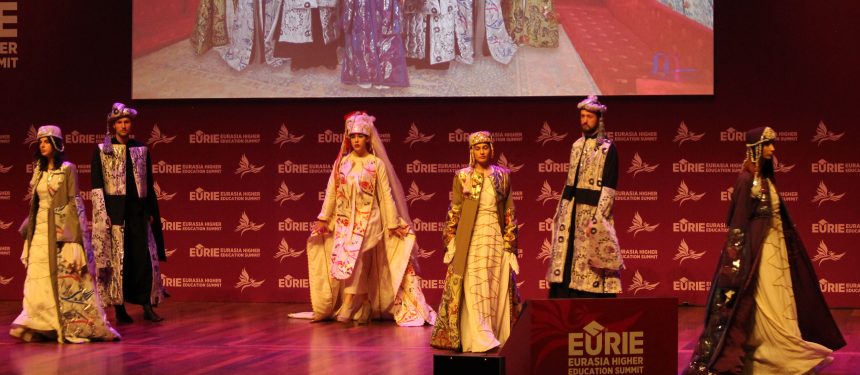“I think we’ve all seen the limitations of student mobility,” Jos Beelen, professor of global learning at The Hague University of Applied Sciences told delegates at the Eurasia Higher Education Summit in Istanbul.
News and business analysis for Professionals in International Education
Have some pie!
Prioritise student and academic involvement in int’l education, EURIE told
 Photo: The PIE News.
Photo: The PIE News. “For more than 30 years we’ve been trying to send students abroad, and if we make it to 20%-25%, we’ve done really well,” he said.
“We are talking about internationalisation for all students”
While 34% of universities in western Europe are prioritising internationalisation, only 10% of universities in Western Asia – including universities in Turkey – prioritise it, Beelen noted.
A diverse classroom mix is not enough, it is “just a starting point”, he explained. Universities need to ensure that home students work with international students in class, he said – and that should be a priority around the world.
“We know that the students we send abroad are socio-economic and socio-cultural elites,” he added. “What we are talking about is internationalisation for all students.”
However, targets for international student numbers are still prevalent globally.
In 2018, the Turkish government joined the fray, announcing a plan to bring 350,000 international students into the country to study at its 206 higher education institutions – and its universities are open for cooperation in all directions.
“[It’s not] about turning East or West – it has to be both,” Ayse Deniz Ozkan, co-ordinator of the EURIE program, said.
“Europe is important for us, we are part of the European Higher Education Area, we are beneficiaries to the Erasmus+ program, which is very important for Turkish universities,” she told The PIE News.
“Of course Turkey is now diversifying… so we are looking to develop more academic collaborations, but also recruiting students from Asia.”
In an emphatic speech, president of EURAS – the Eurasian Universities Union – Mustafa Aydin spoke of confidence in the region’s universities achieving their aims and breaking the sector model for success.
“There is no set of rules that says that the only innovative ideas are going to come from MIT, Berkeley or other such universities,” he said. “Innovative ideas can come from an elementary school in a village or a university that is low in the rankings.”
“They have inherited better opportunities, it doesn’t mean that [we are] not capable of anything less than them… We are always going to strive for more,” he noted.
As Turkish universities seek to diverse their portfolios, research projects and classrooms, according to Ozkan, China is a key player they are looking to connect with.
“When you talk about China, of course you see UK institutions there because they are interested in recruiting Chinese students, but you also see Turkish universities because they are interested in this rising power to the east of us, and there are more collaboration opportunities there,” she said.
“Innovative ideas can come from elementary schools or a low-ranked university”
In terms of research and development output, China’s universities are quickly catching up with its competitors, according to deputy vice president (global business development) at King’s College London, Tayyeb Shah.
“Elite Chinese universities are now capable of delivering world-class research and teaching much like universities in the west,” he said.
“Chinese universities are receiving far greater funding than any of the western universities in terms R&D spend and recruiting academic talent,” Shah added.
With almost 3,000 universities and the second largest recipient of international students after the US, the country’s total R&D expenditure will soon overtake the US, resulting in improved quality of Chinese research, Shah predicted.
While China remains an important source market and its universities become increasingly notable research partners, Beelen highlighted that internationalisation must reach all university members.
Future priorities should focus on involving academics, he argued.
While only 10% of universities in Europe actually focus on internationalisation training in professional development for academics, universities should be seeking to involve professors and lecturers more.
Virtual exchange is a way to reach students who may not be mobile, according to Waidehi Gokhale, CEO of Soliya, a Virtual Erasmus provider.
“Traditionally when we talk about campus internationalisation, that entails students leaving the campus to go elsewhere and students being brought onto campuses,” Gokhale said.
Unlike MOOCs, online learning, and social media, “the idea in virtual exchange is that the pedagogical flow is multidimensional and multidirectional”, Gokhale explained.
The Erasmus+ Virtual Exchange program, launched in 2018 as a pilot project and sought to reach 25,000 people aged 18-30 between 2018-2020, across 43 countries, is one example of that.
Aimed towards southern Mediterranean partners, around 8,200 people engaged in the project in 2018, with Tunisia leading the number of participants with 1,125.
“In the long run we are hoping this will be a much more global initiative”, Stephanie Siklossy project manager at Search for Common Ground, one of the organisations involved in the project, highlighted.
Still looking? Find by category:


